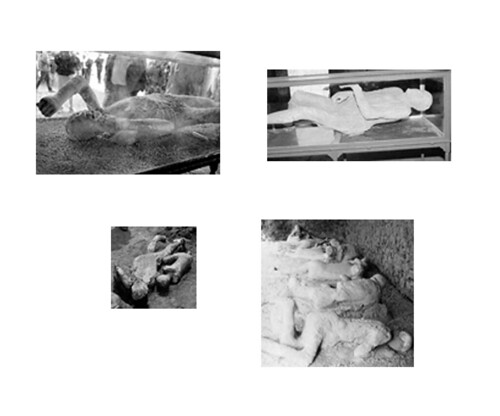
Plaster casts of the remains of the victims at Pompeii.
Archaelogists realized that because of the conditions in which the remains were buried, the ash had compressed to form perfect moulds around the bodies. At first, the excavators could tell when they had found one of these moulds, but they were unsure how to preserve them. It took some ingenuity, but someone thought of plaster, which could be poured into the cavities and allowed to dry. Once the plaster set, the ash could be cleared away, and the victim's shape would be revealed.
Remains like these give us an even clearer picture of the demise of Pompeii and its unlucky inhabitants. Although these pictures are not the most clear, the quality of these plaster casts is chilling. In many cases, you can see facial expressions and features on the bodies. The belts worn by slaves to denote their status are discernable on others.
One final note about Pompeii. It was a city with as many as 20,000 residents in 79 AD. It was completely buried for almost 1700 years, until site was rediscovered and the first excavations began in the 1750's. Unfortunately, the areas first uncovered are starting to decay, and efforts are being made to preserve 2000 year-old ruins that have now been exposed to the elements for over 200. It is encouraging to see the efforts being made to preserve this treasure. Best of all, there is still as much as 1/4 of the city still buried. Historians and archaeologists determined that it's best to leave parts of the site still buried, so that future generations and their ever-advancing technologies will have a crack at Pompeii.




1 comment:
Beagan, I loved seeing these photos, especially the ones from Italy. I will be sure that CSB takes a look, too, since he was on that trip with you all those years ago.
You may recall that we have several of these prints up on our walls. Would you mind if I made up a few more to add to the collection?
Post a Comment